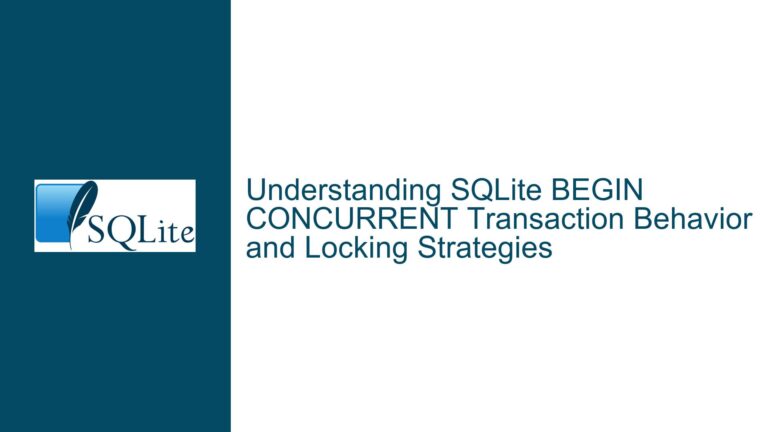Enforcing Cross-Table Validation in SQLite CHECK Constraints and Foreign Keys
Understanding the Limitations of CHECK Constraints with Subqueries and Foreign Key Validation
The core challenge revolves around enforcing data integrity rules in SQLite where a column’s value must exist in a dynamically maintained list of valid values stored in another table. The initial approach attempted to use a CHECK constraint with a subquery to validate against the external table, but SQLite explicitly prohibits subqueries in CHECK constraints. A secondary approach using foreign keys initially failed due to a misconfiguration. This guide explores the technical limitations, root causes, and actionable solutions for enforcing cross-table validation in SQLite.
Technical Constraints of SQLite CHECK Constraints and Foreign Key Configuration
Subqueries in CHECK Constraints Are Not Supported
SQLite’s CHECK constraints are designed to evaluate static or deterministic expressions that do not require external context or runtime evaluation of other tables. This design choice ensures that constraints can be validated efficiently during data insertion or modification without introducing dependencies on external schema states. When a subquery is embedded within a CHECK constraint, SQLite raises a parse error because subqueries inherently depend on external data that may change over time, violating the atomicity and predictability required for constraint validation.
In the provided example, the user attempted to create a table tblxy with a column key constrained to values existing in the valid column of tblelg:
CREATE TABLE tblxy (
key TEXT CHECK (key IN (SELECT valid FROM tblelg))
);
This fails because the SELECT valid FROM tblelg subquery is disallowed in the CHECK constraint. SQLite’s parser rejects this syntax outright, preventing the table from being created.
Foreign Key Constraints Require Explicit Configuration
Foreign key constraints in SQLite provide a mechanism to enforce referential integrity between tables. However, unlike other database systems, SQLite does not enable foreign key enforcement by default. The PRAGMA foreign_keys setting must be explicitly set to 1 (enabled) at the start of every database connection. If this step is omitted, foreign key constraints are silently ignored, leading to unexpected behavior where invalid data can be inserted into the referencing table.
The user’s initial foreign key implementation failed because they omitted PRAGMA foreign_keys=1;:
CREATE TABLE tblelg (
valid TEXT NOT NULL UNIQUE
);
CREATE TABLE tblxy (
key TEXT NOT NULL REFERENCES tblelg(valid)
);
Without enabling foreign keys, the REFERENCES clause had no effect, allowing values not present in tblelg to be inserted into tblxy.
Schema Design Requirements for Foreign Keys
Foreign key constraints require the referenced column(s) to be explicitly defined as UNIQUE or part of a PRIMARY KEY. If the target column lacks a uniqueness constraint, SQLite cannot enforce referential integrity because multiple rows in the referenced table could theoretically match the foreign key value, leading to ambiguity. In the example, tblelg.valid was correctly defined as NOT NULL UNIQUE, satisfying this requirement. However, omitting UNIQUE would result in a foreign key error during table creation.
Root Causes of Validation Failures and Configuration Oversights
1. Misunderstanding CHECK Constraint Capabilities
A common misconception is that CHECK constraints can dynamically reference other tables, similar to how triggers operate. However, CHECK constraints in SQLite are limited to expressions that can be evaluated without context from other tables or subqueries. This limitation ensures constraints are evaluated atomically during row insertion/update, without requiring locks or transactions spanning multiple tables.
2. Foreign Key Enforcement Disabled by Default
SQLite’s decision to disable foreign key enforcement by default stems from backward compatibility considerations. Legacy applications built before foreign key support was introduced (SQLite 3.6.19 in 2009) might rely on the absence of such enforcement. Consequently, developers must explicitly enable foreign keys for each database connection, a step that is easy to overlook.
3. Inadequate Uniqueness Constraints on Referenced Columns
Foreign key constraints implicitly require the referenced column to be unique. If tblelg.valid were not declared as UNIQUE, the foreign key constraint in tblxy would fail with an error during table creation:
Error: foreign key referenced column 'valid' is not unique
This error prevents the creation of an invalid foreign key relationship but can be confusing if the schema designer assumes uniqueness without explicitly enforcing it.
Implementing Robust Cross-Table Validation Using Foreign Keys and Triggers
Step 1: Enabling Foreign Key Enforcement
Before creating tables or inserting data, enable foreign key support for the database connection:
PRAGMA foreign_keys = 1;
This setting must be applied at the start of every new database connection. For persistent configurations, consider wrapping this pragma in application code or initialization scripts.
Step 2: Designing Tables with Proper Constraints
Create the referenced table with a UNIQUE constraint on the validation column:
DROP TABLE IF EXISTS tblelg;
CREATE TABLE tblelg (
valid TEXT NOT NULL UNIQUE
);
INSERT INTO tblelg(valid) VALUES ('F'), ('R'), ('P');
The NOT NULL and UNIQUE constraints ensure that valid contains only distinct, non-null values.
Create the referencing table with a foreign key constraint:
DROP TABLE IF EXISTS tblxy;
CREATE TABLE tblxy (
key TEXT NOT NULL REFERENCES tblelg(valid)
);
The REFERENCES clause links tblxy.key to tblelg.valid, ensuring that any value inserted into key exists in tblelg.valid.
Step 3: Validating Foreign Key Enforcement
Attempting to insert an invalid value into tblxy will now fail:
INSERT INTO tblxy(key) VALUES ('X');
SQLite raises an error:
FOREIGN KEY constraint failed
This confirms that foreign key enforcement is active and functioning.
Step 4: Handling Dynamic Valid Value Updates
To modify the list of valid values, simply update tblelg:
-- Add a new valid value
INSERT INTO tblelg(valid) VALUES ('A');
-- Remove an existing value
DELETE FROM tblelg WHERE valid = 'P';
The foreign key constraint automatically enforces these changes for future inserts/updates in tblxy. Existing rows in tblxy that reference removed values in tblelg will not be affected unless a cascading action is specified.
Step 5: Implementing Triggers for Advanced Validation
For scenarios requiring additional validation logic (e.g., auditing, complex conditions), use triggers. Create a BEFORE INSERT trigger on tblxy to enforce validation:
CREATE TRIGGER validate_tblxy_key
BEFORE INSERT ON tblxy
FOR EACH ROW
WHEN NOT EXISTS (SELECT 1 FROM tblelg WHERE valid = NEW.key)
BEGIN
SELECT RAISE(ABORT, 'Invalid value for key: not found in tblelg.valid');
END;
This trigger explicitly checks for the existence of NEW.key in tblelg.valid and aborts the operation if the check fails. Triggers provide flexibility but introduce additional overhead compared to foreign keys.
Step 6: Verifying Constraint and Trigger Behavior
Test the integrity checks with a series of inserts:
-- Succeeds
INSERT INTO tblxy(key) VALUES ('F');
-- Fails due to trigger or foreign key
INSERT INTO tblxy(key) VALUES ('Z');
Use PRAGMA foreign_key_check; to identify existing rows in tblxy that violate foreign key constraints after modifying tblelg.
Step 7: Comparing Foreign Keys and Triggers
- Foreign Keys:
- Pros: Native enforcement, low overhead, cascading actions (
ON DELETE CASCADE,ON UPDATE SET NULL). - Cons: Requires
UNIQUEconstraint on the referenced column, enabled via pragma.
- Pros: Native enforcement, low overhead, cascading actions (
- Triggers:
- Pros: Customizable logic, ability to reference multiple tables, no uniqueness requirement.
- Cons: Higher overhead, manual maintenance, potential for logic errors.
Step 8: Addressing Schema Modifications
If the list of valid values needs to be expanded to multiple columns or tables, consider normalizing the schema further. For example, introduce a validation_categories table with columns category and value to support multiple validation lists:
CREATE TABLE validation_categories (
category TEXT NOT NULL,
value TEXT NOT NULL,
UNIQUE(category, value)
);
INSERT INTO validation_categories (category, value)
VALUES
('eligibility', 'F'),
('eligibility', 'R'),
('status', 'A'),
('status', 'B');
CREATE TABLE tblxy (
key TEXT NOT NULL,
category TEXT NOT NULL,
FOREIGN KEY (category, key) REFERENCES validation_categories(category, value)
);
This approach allows scalable validation across multiple categories without altering table structures.
Summary of Key Takeaways
- CHECK Constraints Cannot Reference Other Tables: Use foreign keys or triggers for cross-table validation.
- Foreign Keys Require Explicit Activation: Execute
PRAGMA foreign_keys = 1;at the start of each connection. - Referenced Columns Must Be Unique: Ensure
UNIQUEorPRIMARY KEYconstraints on columns targeted by foreign keys. - Triggers Offer Custom Validation Logic: Use for complex scenarios but be mindful of performance implications.
- Schema Design Impacts Maintainability: Normalize validation lists and leverage SQLite’s relational features for scalable solutions.
By adhering to these principles, developers can enforce robust data integrity rules in SQLite, adapting to evolving validation requirements without resorting to frequent schema modifications.






